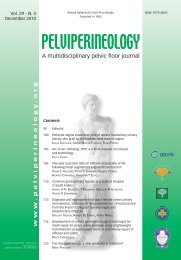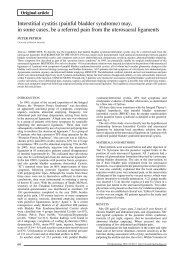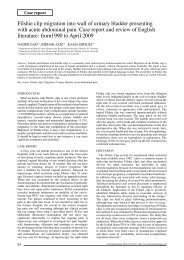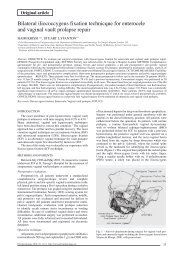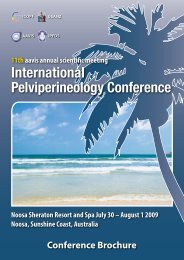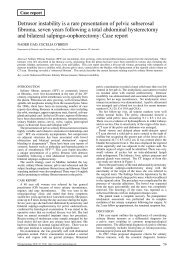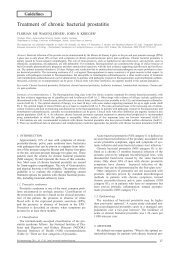This Issue Complete PDF - Pelviperineology
This Issue Complete PDF - Pelviperineology
This Issue Complete PDF - Pelviperineology
You also want an ePaper? Increase the reach of your titles
YUMPU automatically turns print PDFs into web optimized ePapers that Google loves.
A. Niesel - O. Gramalla - A. Rohne<br />
compartment recurrence occurred in 3 patients (12 %) with<br />
POP-Q = Stage 2. There was no relapse in the middle or<br />
posterior compartment (POP-Q: Stage 0 or 1) (Tab. 2).<br />
Vaginal erosion of the mesh as a simple healing abnormality<br />
affected one patient (4 %) after cystocoele and one<br />
(4.5 %) after rectocoele repair. The vaginal erosion measured<br />
POPQ IIº 12% 0% 0%<br />
(%)<br />
mesh-erosion 4% 0% 4,5%<br />
(%) (n = 1) (n = 1)<br />
DISCUSSION<br />
A number of parameters affect the ability of a synthetic<br />
mesh to act as the perfect graft. These include: kind of<br />
material (e.g. polypropylene, polyester), textile construction<br />
(mass per unit area), configuration of the thread (monofilament,<br />
multifilament, fleece), pore size, elasticity, and the<br />
amount of ingrowth of connective tissue. Physical characteristics<br />
may play a significant role in respect to the biocompatibility<br />
of prosthetic materials in human tissue.<br />
Partially absorbable meshes such as SeraGYN ® PFI or<br />
Seratom ® A PA are likely to have four advantages:<br />
– weight reduction;<br />
– monofilament surface during critical postoperative phase<br />
with less risk of inflammation;<br />
– masking the hydrophobic surface of polypropylene. For<br />
this reason better acceptance in the tissue is expected;<br />
– more softness, like multifilament grafts.<br />
Previously available composite meshes such as Vypro<br />
II ® ( Ethicon, USA) were made of two separate threads of<br />
PP and polyglycolacid and did not meet the criteria of an<br />
ideal mesh for induration and shrinkage. 7 The SeraGYN ®<br />
PFI or Seratom ® A PA partially absorbable graft consists of<br />
a single thread made up of a coating of polyglycolacid /<br />
-caprolacton and a core of six PP-filaments. The primary<br />
monofilament mesh has the advantage of avoiding early<br />
rejection or inflammation then it converts to a hexafilament<br />
graft with reduced rigidity after reabsorption of the cover. As<br />
the distance between the filaments is > 10 m, the migration<br />
of leucocytes and macrophages, that may counter invading<br />
bacteria, is not hindered in contrast to conventional multifilament<br />
and microporous meshes (Amid II-IV classification).<br />
8<br />
Seratom ® A PA weighs 15 g/m 2 and contains the lowest<br />
proportion of foreign material in comparison with other<br />
grafts in this trial (Fig. 3). Despite the reduced weight no<br />
deficits were found in our in-vitro testing of stability and<br />
flexibility. In relation to flexural rigidity the partially absorbable<br />
graft demonstrates at least twofold less stiffness than<br />
the non resorbable prosthetic materials. In respect to breaking<br />
strength the partially absorbable mesh is as firm as the<br />
other grafts.<br />
It is apparent that physical properties of the prosthetic<br />
material contribute to the incidence of complications in<br />
pelvic floor reconstruction. There has been a lot of effort<br />
undertaken within the last few years to produce lightweight<br />
biocompatible grafts. Mesh erosions are not only caused by<br />
problems with surgical technique and patient’s own risk factors<br />
but also by the kind of implant (Tab. 3). Julian, 14 in a<br />
randomised controlled trial found an erosion rate of 25%<br />
with a Marlex PP mesh but in most trials it is quoted at<br />
8-12%. 9 Our experiences with the partially absorbable mesh<br />
show a considerably reduced erosion rate of 4-4.5% after a<br />
mean follow-up of 1 year (range 10-14 months). The erosions<br />
happened in the anterior as well as in the posterior<br />
vaginal wall in a very circumscribed area. The problem was<br />
resolved by simple excision of the small area of unincorporated<br />
mesh. No major visceral complications were seen.<br />
The mesh proved as a safe and effective graft in pelvic<br />
floor reconstruction even in advanced vaginal prolapse<br />
(POP-Q Stage 3-4). <strong>This</strong> study is limited in that it is a retrospective<br />
survey in a small population without any quality of<br />
life questionnaire.<br />
Efficient and objective trials are mandatory to fully evaluate<br />
the place for partially absorbable meshes. The Pareto-<br />
(partially resorbable transobturatoric) mesh study began in<br />
April 2007 as a prospective randomised multicenter study<br />
with the study center at the Gynecological Clinic, University<br />
of Freiburg, Germany. A non resorbable 6 armed PPmesh<br />
prosthesis for reconstruction of cystocele and vault<br />
prolapse is compared with a partially reabsorbable graft of<br />
the same size. The primary question that has to be answered<br />
is if the erosion rate can be reduced by the use of the partially<br />
absorbable mesh. Other factors that are thought to<br />
affect the erosion rate will also be examined. These include<br />
collagen content, extracellular matrix proteins, degree of<br />
proliferation of vaginal epithelium and bacterial colonization.<br />
The surgical technique is standardized and follow-up is<br />
planned after 3 months, one and three years. First results for<br />
publication are expected at the end of 2008.<br />
TABLE 3. – Factors in aetiology of mesh erosion<br />
• As a consequence of operation<br />
(simultaneous hysterectomy, inverse T- incision?, 9<br />
excessive excision of vaginal skin, extent of colpotomy, 9<br />
supra-fascial dissection, 10, 12 lack of experience, 11<br />
taut suture of vaginal skin, excessive tension of mesh 13 )<br />
• Patient risk factors<br />
(poorly controlled diabetes mellitus, tobacco use, 13<br />
vaginal prolapse, POPQ < 2, 12 repeat procedures,<br />
medication of cortisone, vaginal estrogen status,<br />
prior history of pelvic irradiation, 13 age < 70 years 11, 12 )<br />
• As a consequence of mesh characteristics<br />
(graft according to Amid classification II-IV, 8<br />
large amount of foreign material)<br />
REFERENCES<br />
1. Shull BL. Pelvic organ prolapse: anterior, superior and posterior<br />
vaginal segment defects. Am J Obstet Gynecol 1999; 181:<br />
611.<br />
2. Weber AM, Walters MD, Piedmonte MR, Ballard LA. Anterior<br />
colporrhaphy: a randomised trial of three surgical techniques.<br />
Am J Obstet Gynecol 2001; 185: 1299-1306.<br />
3. Nilsson CG. Introduction of a new surgical procedure for treatment<br />
of female urinary incontinence. Acta Obstet Gynecol<br />
Scand 2004; 83: 877-880.<br />
24



